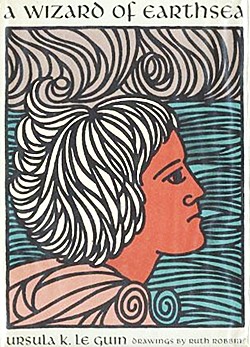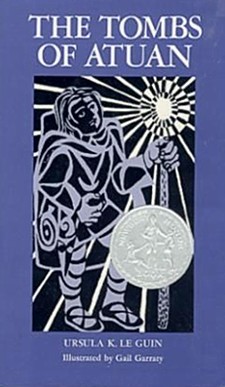
A Wizard of Earthsea is a fantasy novel written by American author Ursula K. Le Guin and first published by the small press Parnassus in 1968. It is regarded as a classic of children's literature and of fantasy, within which it is widely influential. The story is set in the fictional archipelago of Earthsea and centers on a young mage named Ged, born in a village on the island of Gont. He displays great power while still a boy and joins a school of wizardry, where his prickly nature drives him into conflict with a fellow student. During a magical duel, Ged's spell goes awry and releases a shadow creature that attacks him. The novel follows Ged's journey as he seeks to be free of the creature.

Ursula Kroeber Le Guin was an American author best known for her works of speculative fiction, including science fiction works set in her Hainish universe, and the Earthsea fantasy series. She was first published in 1959, and her literary career spanned nearly sixty years, producing more than twenty novels and over a hundred short stories, in addition to poetry, literary criticism, translations, and children's books. Frequently described as an author of science fiction, Le Guin has also been called a "major voice in American Letters". Le Guin said she would prefer to be known as an "American novelist".

The Tombs of Atuan is a fantasy novel by the American author Ursula K. Le Guin, first published in the Winter 1970 issue of Worlds of Fantasy, and published as a book by Atheneum Books in 1971. It is the second book in the Earthsea series after A Wizard of Earthsea (1969). The Tombs of Atuan was a Newbery Honor Book in 1972.

The Earthsea Cycle, also known as Earthsea, is a series of high fantasy books written by the American author Ursula K. Le Guin. Beginning with A Wizard of Earthsea (1968), The Tombs of Atuan, (1970) and The Farthest Shore (1972), the series was continued in Tehanu (1990), and Tales from Earthsea and The Other Wind. In 2018, all the novels and short stories were published in a single volume, The Books of Earthsea: The Complete Illustrated Edition, with artwork by Charles Vess.

Orsinian Tales is a collection of eleven short stories by American writer Ursula K. Le Guin, most of them set in the imaginary country of Orsinia.

Rocannon's World is a science fiction novel by American writer Ursula K. Le Guin, her literary debut. It was published in 1966 as an Ace Double, along with Avram Davidson's The Kar-Chee Reign, following the tête-bêche format. Though it is one of Le Guin's many works set in the universe of the technological Hainish Cycle, the story itself has many elements of heroic fantasy. The hero Gaveral Rocannon encounters lords who live in castles and wield swords, and other races much like fairies and gnomes, in his travels on a backward planet.

Always Coming Home is a 1985 science fiction novel by American writer Ursula K. Le Guin. It is in parts narrative, pseudo-textbook and pseudo-anthropologist's record. It describes the life and society of the Kesh people, a cultural group who live in the distant future long after modern society has collapsed. It is presented by Pandora, who seems to be an anthropologist or ethnographer from the readers' contemporary culture, or a culture very close to it. Pandora describes the book as a protest against contemporary civilization, which the Kesh call "the Sickness of Man".

City of Illusions is a 1967 science fiction novel by American writer Ursula K. Le Guin. It is set on Earth in the distant future, and is part of her Hainish Cycle. City of Illusions lays the foundation for the Hainish cycle which is a fictional universe in which the majority of Ursula K. Le Guin's science fiction novels take place.
"The Word of Unbinding" is a short story by American writer Ursula K. Le Guin, first published in the January 1964 issue of Fantastic, and reprinted in collections such as The Wind's Twelve Quarters. In this story, the Earthsea realm, which was later made famous by A Wizard of Earthsea, was first introduced. Along with the story "The Rule of Names", this story conveys Le Guin's initial concepts for the Earthsea realm, most importantly its places and physical manifestation, but not the characters appearing in the novels.

The Wind's Twelve Quarters is a collection of short stories by American writer Ursula K. Le Guin, named after a line from A. E. Housman's A Shropshire Lad, and first published by Harper & Row in 1975. A retrospective of Le Guin's short stories, it collects 17 previously published pieces of speculative fiction. Four of these were the germs of novels she was to write later, and a few others shared connections to Le Guin novels. At least four stories are set in the Hainish Universe, and two others in Earthsea. Many stories share themes and motifs, including time and utopia: certain images and characters also recur, including isolated scholars or explorers seeking knowledge in a hostile world.

Four Ways to Forgiveness is a collection of four short stories and novellas by American writer Ursula K. Le Guin. All four stories are set in the future and deal with the planets Yeowe and Werel, both members of the Ekumen, a collective of planets used by Le Guin as part of the background for many novels and short stories in her Hainish Cycle. In 2017 it was reissued in the second volume of Hainish Novels & Stories and as an e-book, augmented with a fifth related story by Le Guin, as Five Ways to Forgiveness.

The Telling is a 2000 science fiction novel by Ursula K. Le Guin set in her fictional universe of Hainish Cycle. The Telling is Le Guin's first follow-up novel set in the Hainish Cycle since her 1974 novel The Dispossessed. It tells the story of Sutty, a Terran sent to be an Ekumen observer, on the planet Aka, and her experiences of political and religious conflicts between a corporatist government and the indigenous resistance, which is centered on the traditions of storytelling, locally referred to as "the Telling".

Steering the Craft: Exercises and Discussions on Story Writing for the Lone Mariner and the Mutinous Crew is a 1998 nonfiction book by Ursula K. Le Guin. Developed from a writers' workshop led by Le Guin, the book contains self-guided exercises and discussions focused on the craft of narrative prose.

The Beginning Place is a short novel by American writer Ursula K. Le Guin, written in 1980. It was subsequently published under the title Threshold in 1986. The story's genre is a mixture of realism and fantasy literature. The novel's epigraph "What river is this through which the Ganges flows?" is quoted from Jorge Luis Borges. The novel has been subject to critical studies comparing it to C.S. Lewis' The Chronicles of Narnia, Lewis Carroll's Through the Looking-Glass and William Shakespeare's As You Like It.
"The Wife's Story" is a short story written by Ursula K. Le Guin.

Ursula K. Le Guin (1929–2018) was an American author of speculative fiction, realistic fiction, non-fiction, screenplays, librettos, essays, poetry, speeches, translations, literary critiques, chapbooks, and children's fiction. She was primarily known for her works of speculative fiction. These include works set in the fictional world of Earthsea, stories in the Hainish Cycle, and standalone novels and short stories. Though frequently referred to as an author of science fiction, critics have described her work as being difficult to classify.

Gifts (2004) is a young adult fantasy novel by Ursula K. Le Guin. It is the first book in the Annals of the Western Shore trilogy, and is followed in the series by Voices. The story is set in a fictional world, in a barren and poverty-stricken region called the Uplands, some of whose inhabitants have hereditary magical gifts. The story follows the narrator Orrec, son of the leader of the domain of Caspromant, whose hereditary gift is the ability to "unmake", and Gry, the daughter of a neighboring domain, who can communicate with animals. Orrec's gift manifests late, and seems uncontrollable, and so he is blindfolded. Their families are caught up in the cycle of violent feuds and retribution that characterize Upland society in which the children are trying to find their place.
"The Dowry of Angyar" is a science fiction short story by American writer Ursula K. Le Guin, first published in 1964. It is the first work of the Hainish Cycle. The story is set on a fictional planet of the star Fomalhaut, and follows a highborn woman as she tries to track down a family heirloom. It was framed by commentary from ethnologists studying the intelligent life-forms of the Fomalhaut system. The story drew from Norse mythology, including the legend of the Brísingamen, and explored the concept of time dilation. "The Dowry of Angyar" drew comments for its stylistic devices, while a review praised Le Guin's writing as "crystalline prose". It was later used as the prologue to Le Guin's 1966 novel Rocannon's World. In later publications, including in the 1975 anthology The Wind's Twelve Quarters, the story was given the title "Semley's Necklace".

"Old Music and the Slave Women" is a science fiction story by Ursula K. Le Guin. It was first published in the 1999 collection Far Horizons, edited by Robert Silverberg, and anthologized multiple times in collections of Le Guin's works. The story is set on the planet of Werel in the fictional Hainish universe, created by Le Guin. That planetary system is also the setting for Le Guin's 1995 story suite Four Ways to Forgiveness. The economy of Werel is based on slavery, and during the period in which the stories are set, the society is experiencing upheaval and revolution.
"The Diary of the Rose" is a 1976 dystopian science fiction novelette by Ursula K. Le Guin, first published in the Future Power collection. The tale is set in a totalitarian society which uses brainwashing by "electroshocks" to eradicate any kind of political dissent.













